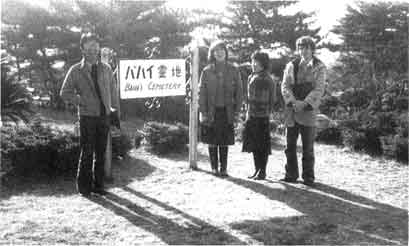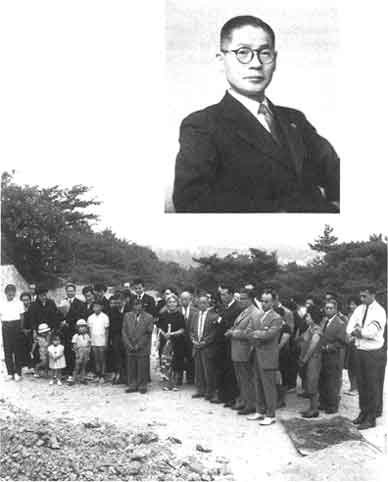
|
Traces That Remain:
A Pictorial History of the Early Days of the Bahá'í Faith among the Japanese
by Barbara R. Sims
edited by Sheridan Sims  |
chapter 75 | start page | single page | chapter 77 |  |
Chapter 76
Mr. Bunshiro Kajimoto and his funeral. He was the first Japanese to be buried in accordance with Bahá'í law in Japan.Mr. Anthony Seto, a Chinese-American Bahá'í had been buried according to Bahá'í law some years earlier in Yokohama.
This was accomplished in 1958 when a large plot of land six hundred twenty-three square meters was obtained within the Ashiya Cemetery.
As it was within the already existing Ashiya Cemetery, it could not be purchased outright. A permanent lease (or "right to use") was purchased and donated to the National Spiritual Assembly of North East Asia by Mr. Abbas Katirai.
The first person to be buried there was Mr. Bunshiro Kajimoto, in 1964. He had become a Bahá'í in November 1961. When he became terminally ill, he and his wife discussed the future and they both decided they wanted to be buried in the Ashiya burial ground in accordance with Bahá'í law. Mr. Kajimoto wrote this in his will.
It was certainly a radical departure from traditional Buddhist burial in which the body is cremated and the ashes put into

click here for larger image
This photo was taken during a visit to the Bahá'í Cemetery in Ashiiya, in February 1979. It shows Mr. David Mockon, Mrs. Sue Sloan, Miss Iwakura and Mr. James Manners. All were members of a one-year full-time travel-teaching team which was organized in Japan to actively pursue certain teaching and consolidation goals of the Five Year Plan (1974-1979.)
an urn which is usually buried.
It was not easy to go against a centuries-old practice in such a conservative country. It attests to Mr. Kajimoto's faith and conviction that he was the first of his Bahá'í countrymen to do so.
The second person to be buried in the Bahá'í Cemetery was Mrs. Sakineh Kazempour, in 1968. She was the mother of Mr. Abbas Kazempour and his sister Mrs. Moluke Kazempour. The elderly Mrs. Kazempour had come to Japan eight years earlier to be with her family who were pioneering.
 |
chapter 75 | start page | single page | chapter 77 |  |
|
|
